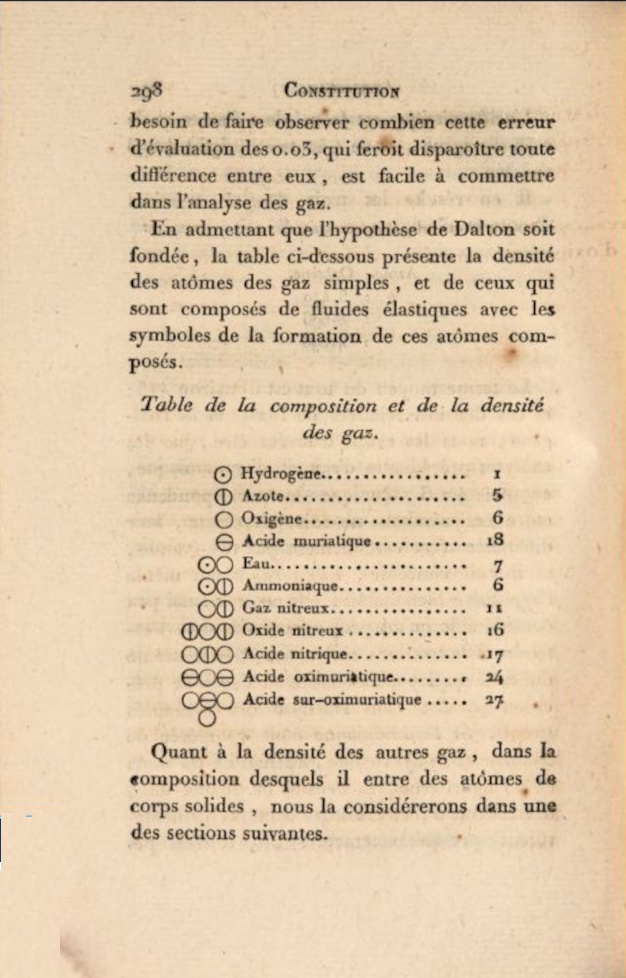Thomas Thomson and Dalton's atomic theory
According to (among others) Wikipedia and Oliver Sacks (Uncle Tungsten, 2001), Thomas Thomson was an early adopter of Daltons atomic theory, presenting it much more clearly than Dalton himself.
Thomson published two major works on chemistry: 1802, «A System of Chemistry of Inorganic Bodies», a work in several volumes that, to my knowledge, reached at least 7 editions. The other book is the «Elements of Chemistry», a digest of the former, published in 1810.
In the first two editions of the «System» Dalton's atomic theory is not used at all.
Prior to the publication by Dalton himself, Thomson, in the third edition, volume 5,
in the chapter on affinity (p. 291-298 in the French translation available
to me; liv. III, De l'affinité, chap. II, Des gaz), gives a short sketch
 of Daltons theory, as far as the «densities of gases» (relative atomic
weights in modern parlance) are concerned. In a note he
warns the reader that he takes this from oral communications with Dalton
and from hasty notes and so the exposition may be faulty. The same treatment of
the matter is found in the fourth (1810) edition, vol. 3, and runs
like this.
of Daltons theory, as far as the «densities of gases» (relative atomic
weights in modern parlance) are concerned. In a note he
warns the reader that he takes this from oral communications with Dalton
and from hasty notes and so the exposition may be faulty. The same treatment of
the matter is found in the fourth (1810) edition, vol. 3, and runs
like this.
In the 1810 «Elements of Chemistry» (ASCII-Text here) only faint traces of what we are used to know as Dalton's Atomic Theory appear: In the chapter on Affinity, beginning on p. 478, Thomson speaks of „particles of bodies“, forming other, „integrant“, particles consisting of different kinds. He never mentions anything about their being of equal size etc. Except for frequently quoting Dalton for experiments, on p. 482 he is quoted as assigning different sizes to particles of different gases. On p. 479 the difference between „homogeneous affinity“ – cohesion – and „heterogeneous affinity“ – causing chemical bonds – is introduced.
Thomson took these considerations from his earlier «System»
Finally, in the 7th (1831) edition of the «System» the introduction contains all the central points of Dalton's theory. The main and indeed very clear exposition is found on pages 3 to 7. After this exposition there follow some very interesting discussions on topics like the size and shape of atoms and the reasons for the way in which compounds are formed from the elements – i.e. a early version of a bond theory – and why some bodies react and some don't.
Sources
For my digitisation of the Introduction of the «System», 7th ed., presented here (link above), I used the scans (42.2 MB) of the first volume of the 7th edition from 1831, provided by googlebooks, and their OCR. A partly emendated version of the complete ASCII text is found here. A scan of the Philadelphia 1803 reprint of the first edition appears here (64.8 MB). The second edtion was available to me in the German translation from 1805 by Friedrich Wolff (Bayerische Staatsbibliothek, signature Chem. 300-1 to Chem. 300-4). The third edtion (1807) was available to me in the French translation from 1809 by J. Riffault, with a 170 pages introduction by C. L. Berthollet (Bayerische Staatsbibliothek, signature BHS I II 37-1 to BHS I II 37-5). The French translator made big efforts to recalculate the English weights and measures into SI-units, correcting also errors made by Thomson. The fourth edition (1810) is available from the NY Public Library.
The «Elements» have been digitized by Google. The OCR, however, worked rather badly in most parts. The pdf file with the scans can be found here (53.2 MB). I emendated the complete text manually. The corrected text is to be found here.
A scan of the «Elements» 1810 Philadelphia edition – pagination different, text identical – is to be found here.
Back to my other chemistry pages.